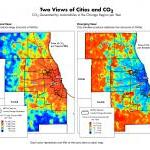
Chicago, IL, 60603: The slide from the Center for Neighborhood Technology shows how dense cities are commonly viewed as areas of concentrated CO2 emissions (when emissions are viewed on a per-square-mile basis) but are actually extremely low producers of such emissions when viewed on a per capita (or per household) basis. Specifically, the average exurban household in a sprawling Chicago exurb generates about 11.5 tons of C02 per year, but those in suburban areas served by commuter rail generate 23% less C02 with their cars, or about 9 tons on average. By moving to a city neighborhood -- or a compact, mixed-use rail-connected suburb such as Evanston or Oak Park -- a household would expect to see their auto-generated C02 drop precipitously to about 2.5 tons per year. They'd be switching to transit for some trips, which involves some generation of greenhouse gases, but at a far, far reduced rate. And more destinations would be within walking and biking distance too.
Credits: Center for Neighborhood Technology


